Versions 9.3 - 9.3.2 General Improvements
Major new features in GainSeeker version 9.3.2
For Python scripts, a new Archive
Script feature  lets you make an offline backup of the current (live) scripts. You
can archive the same script multiple times to keep a revision history
of the script.
lets you make an offline backup of the current (live) scripts. You
can archive the same script multiple times to keep a revision history
of the script.

There are also methods to archive
multiple scripts, such as all scripts for an inspection, a dashboard,
or a configuration.
Updating to GainSeeker 9.3.2 (or later) will create a new SCRIPTARCHIVE
table for each HSISCRIPTS table and update your configurations
to point to these new SCRIPTARCHIVE tables. A new sql.tables.scriptarchive
Python command returns the name of this table for the current configuration.
You can now set up a Custom
color palette that makes it easier to pick the same colors for
charting and inspection items that display the standard Microsoft
color selection window.
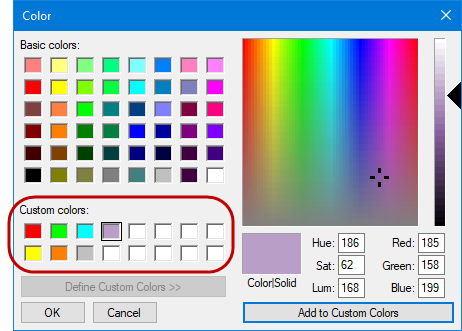
Other new features in GainSeeker version 9.3.2
Installation
The GainSeeker client installation program no longer installs
the *.vsf files used by the legacy Version Verify utility.
Documentation for Installing
the GainSeeker client has been updated to clarify that you
must use the Setup.exe file -
and not the
.msi file in the same folder -
to launch the client installation.
Inspections
For Inspections, the Date/Time test has a new Required
property that can force the inspector to change the date/time
before they are able to Submit the current sub-inspection. A corresponding
Python command, inspect.cursubi.datetime(idx).required,
has also been added.
Documentation for a Numeric Input test with the SPCStandardSelection
property set to DoNotStore
has been updated to note that any side
panel charts linked to this test will not be refreshed when
the sub-inspection is Submitted.
Charting and Analysis
Two new date periods - Current
Shift and Previous Shift - make it easier to analyze only
the data for the current or previous shift.
When data is grouped
on a Control chart, group labels can now be staggered over two
or three levels (depending on the font and font size used for
group labels) to reduce overlapping.
If you use the DMS cost analysis features to report a metric
other than "cost" - such as weight, time, etc. - you
can use two new Cost
charts settings to make charts and reports reflect this other
metric and hide the currency symbol.
When displaying a Scatter Plot for continuous data from
the Variation Wizard or from the Big Data SPC dashboard control,
the Best Fit line is now drawn on the chart, and the Regression
Line equation and Correlation value are now displayed at the bottom
of the chart.
When sending a Desktop to PowerPoint, the GainSeeker Charts
module now maximizes each chart window before capturing its image
and sending to PowerPoint. This can greatly improve the resolution
of the resulting PowerPoint images, especially for Desktops that
contain many chart windows.
You can now copy
a Desktop. This makes it easier to create a new name for an
existing Desktop.
When creating or editing a filter, it is now easy to build
a multi-row filter for multiple Part Numbers or Processes.
The Legend
for the Monitor Table now reflects the colors displayed on
the table rows - either real-time failure colors or user-defined
colors.
DPU and OEE charts can now be grouped by 1-minute time increments.
For implementations of high-speed data collection (multiple data
records entered per minute), this allows for more granular analysis
of that data.
Documentation for Statistical
Validation now provides links to download the Statistical
Qualifications Testing documents for the current version of GainSeeker.
Python
You can use the new Python commands dashboard.getname()
and dashboard.getcaption()
to get the name and caption of the current dashboard.
You can use the new Python commands inspect.subi(id).visible and inspect.subi(id).color to change how a sub-inspection
is displayed in the list of sub-inspections, by hiding it or making
it visible, and by customizing its background color. Both of these
commands can use the new sub-inspection
Index property which
represents a sub-inspection's position in the list of sub-inspections.
You can use the new Python command inspect.cursubi.ni(testid).focuscell(idx) to set the focus to the specified
data entry cell in a Numeric Input test.
The new Python command inspect.cursubi.getmedia()
gets a list of all media (image and video) file paths that have
been attached to the current sub-inspection. This makes it possible
to send email and attach any images or video that are attached
to the sub-inspection.
When displaying a custom Python form, the Python command
disp.addbtn()
can now display up to 10 buttons.
When using Python to build and store DMS data records, you
can now use the defect ID number instead of the defect description
with the new datadms.setdefectid()
command.
When creating a Device
Profile in Advanced Profile mode, the script editor window
now displays the serial setup code and serial close code that
will be automatically generated and run at the beginning and end
of this profile's serial communication for the inspection. This
helps users to streamline their scripts and improve the speed
of serial data collection.
Documentation for the Python
Script Library now includes information for requesting access
to ftp://ftp.hertzler.com/python
and its sub-folders if you cannot access the Script Library.
Documentation for the Python file.xls
commands has been updated with instructions for dealing with ASCII
null characters in text files.
Other modules
You can now configure any GainSeeker user to automatically
receive email
alerts whenever certain Audit Trail events are logged.
Configuring user-defined
colors for the Monitor Table now allows you to type any traceability
value instead of forcing you to select from the pre-defined list
of traceability values.
Documentation for creating a GainSeeker shortcut that specifies
a GainSeeker
database connection has been updated to include ConnectString="[iList]"
which lets the user choose from a list of database connections.
Major new features in GainSeeker version 9.3
Localization support for Spanish and French
added to PC Collect
The PC Collect module can now display all
menus, prompts, windows, etc. in Spanish or French (as well as English).
This makes it much easier for data entry users to understand and interact
with the PC Collect module for data entry.
The language used by PC Collect can be set
by a command line parameter, a language setting for the GainSeeker user,
or the language currently being used by Windows. The user can also use
the menu to manually change the language.
These changes also make it possible to enter
and edit data, standards, etc. in non-legacy modules such as PC Collect
and GainSeeker Charts when the Windows language uses a comma or other
symbol as the decimal separator.
For details about running PC Collect in another
language, see Setting
the PC Collect Language to Spanish, French, or English.
A new login.language
Python command makes it possible to display different custom messages
based on the current PC Collect language.
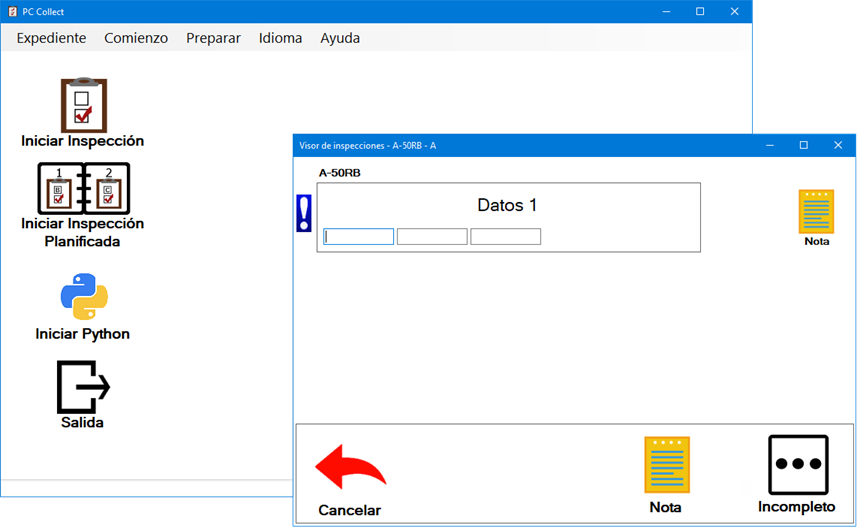
Data Canvas helps users visualize data entry
for improved accuracy in PC Collect
A sub-inspection with Numeric Input tests
for measurement data can now display those tests on the side panel in
a Data
Canvas. As the user – or a connected device – enters data for these
Numeric Input tests, those values are also displayed at the corresponding
locations on the Data Canvas.
For a sub-inspection with many Numeric Inputs,
this helps the data entry user to quickly understand which measurement
is generating real-time alarms and immediately take appropriate steps.
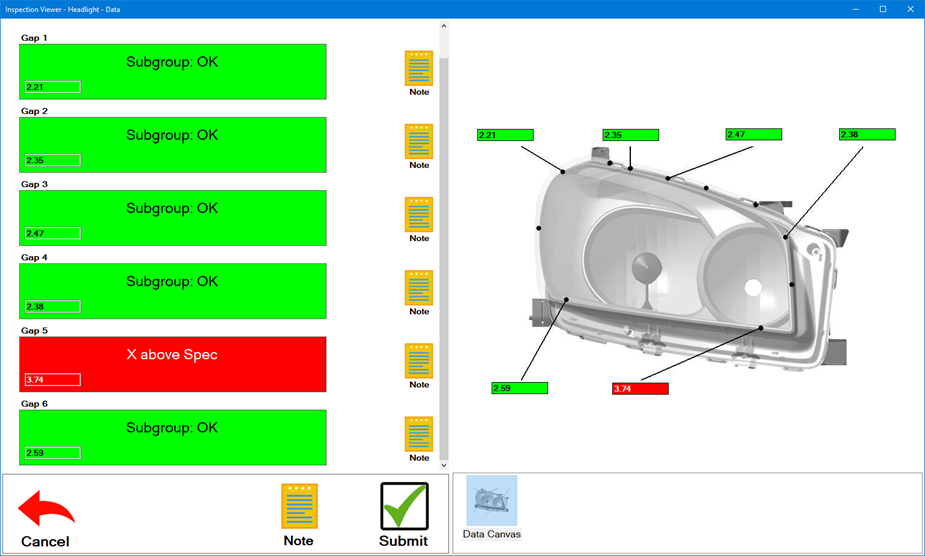
Dynamic Reports 2
A new version of Dynamic Reports – Dynamic
Reports 2 – is easier to work with when designing reports, and it
offers new functionality such as data retrievals based on Python scripts
and support for GainSeeker custom statistics.
Any existing reports can be automatically
imported into the Dynamic Reports 2 platform.
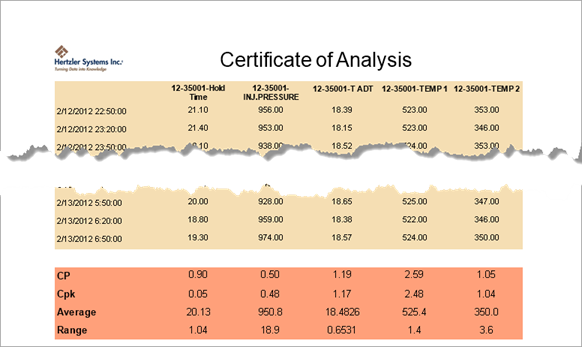
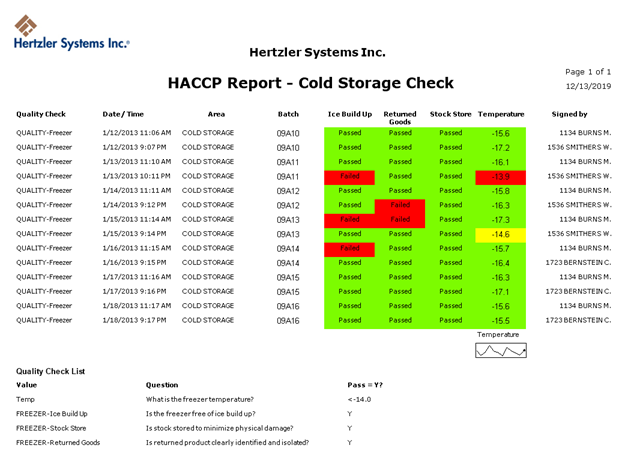
Major Improvements to Side Panel Chart in
PC Collect
You can now ensure that Numeric Input tests
and their corresponding side panel charts are filtering for the same values
when calculating Control Limits for real-time failures. For more information,
see Numeric
Input Filter property, Numeric
Input AutoSendRTFEmail property,
SPC Chart Options,
and DMS Chart
Options.
Charts are now drawn more quickly in PC Collect,
and we have streamlined how often we update those charts to speed your
process of data entry.
There is also a new set of Python inspect.sidepanel
commands for side panel charts (and other tabs on the side panel) to give
you better control of what is displayed on the side panel during inspection
data entry.
MINITAB 19 now supported
GainSeeker is now configured to work with
MINITAB
19.
New recommendation
for iPad data entry
For new deployments using iPads or other
mobile tablets for data entry into GainSeeker, Hertzler Systems now recommends
the use of a Microsoft Remote Desktop Client app to connect to a PC (or
Remote Desktop Session Host server / Terminal server) that runs the full
GainSeeker client.
This permits the use of Python scripting
to customize data entry inspections and lets you take advantage of the
growing list of data entry features available for the PC Collect module.
This also makes it easy to create one inspection that works correctly
on both PC and mobile platforms.
This new recommendation supersedes earlier
recommendations to use the GS Collect app (which supports LiveCode scripting
but not Python scripting) and the GainSeeker Mobile Web Service for iPad
data entry.
For details, see Mobile
App Requirements.
Other new features in GainSeeker version 9.3
Installation
Multiple modules
A new Monitor
Table Colors and Priority setting in System Administration
now determines how colors are applied to the Monitor Table in
the GainSeeker Charts module. Monitor Table colors can now be
based on either the real-time failure colors (like previous versions)
or on color rules that you define, based on traceability and corrective
action values in the data.
Surge licenses are now available to temporarily increase
your GainSeeker license count until a specified expiration date.
This can be useful when you temporarily increase the number of
concurrent GainSeeker users - for example, when employing summer
interns to work on GainSeeker projects, or when conducting a GainSeeker
training class.
For information on installing a Surge license, see Importing
a License File.
If you change
a defect name, GainSeeker will now generate a list of the
inspections and Python scripts that you may need to manually update
to use the new name. If the old name contained one of six special
characters (< > & \ " or '), some of the inspections
and scripts displayed may not actually require updating.
If your computer has a microphone, you can use built-in
Windows functionality to speak text and characters instead of
typing them on the keyboard. This can be used in any part of GainSeeker
where you are expected to enter text, such as fields for data
or notes. For more information, see Convert
speech to text with Windows dictation.
By default, GainSeeker charts and dashboards now display
the "Powered by GainSeeker" watermark in the upper left
corner. You can turn off this watermark for all configurations
by clearing the Hide "Powered
by GainSeeker" watermark in GainSeeker Charts check
box in System-wide
settings.
When selecting a default
report for Statistics List,
Statistics Table, or any
of the Statistics under...
settings, you can now copy the Default
report to a new report.
GainSeeker Inspections
You can now use inspections with Python scripts to read
data from Solartron Orbit 3 devices. This is implemented with
a new Numeric Input test property SolartronSettings,
new Python solartron commands, and a new Python
inspect.cursubi.ni(idx).solartronmoduleid command.
The FormulaMode
property of a Formula test has a new ClickToggle
option that lets the inspector click a button to start running
a script, which runs repeatedly until the inspector clicks the
button again to finish running the script. This is especially
useful in conjunction with the new Data Canvas feature (above).
A new RunningLabel property
for the Formula test also sets the label for this button while
the script is running, and this label can be changed by the new
inspect.cursubi.formula(idx).labelwhilerunning
Python command.
A new sub-inspection property, CombinedFailureResponse,
lets you send an email notification for all Numeric Input test
on this Sub-Inspection that were submitted with real-time failures.
It is useful for situations where one sub-inspection might have
multiple Numeric Input tests that fail and you prefer to receive
one summary email for the sub-inspection instead of a separate
email for each Numeric Input test that failed on the sub-inspection.
A corresponding Python command, inspect.cursubi.combinedfailureresponse,
is also available.
When editing LiveCode script, GainSeeker now uses a monospaced
font in a larger font size to improve legibility.
Deleted Device
Profiles for RS-232 input are now logged to the Audit
Trail.
PC Collect
Documentation for performing Numeric Input tests now includes
instructions for completing
the subgroup when a measurement is missing.
During RS-232 data entry, if the inspector presses CTRL+K
to enter a data value via keyboard, they can now enter
an asterisk ( * ) in place of a missing measurement.
On a Numeric Input test with real-time failures, font colors
on the test and its individual note are now automatically adjusted
for legibility against backgrounds with darker real-time failure
colors.
Python
You can use the new commands disp.btnaccept()
and disp.btncancel()
to configure custom forms that allow the user to press the Enter
key or Esc key instead of clicking a button on the form.
The new inspect.cursubi.trace(idx).getindex()
command gets the number of the traceability field assigned to
a particular Traceability test.
The new commands inspect.cursubi.defectlist().visible
and inspect.cursubi.dmspart().visible
let you change (or get) whether a Defect List test or DMS Standard
test is visible.
The new inspect.cursubi.ni(idx).getrtfnote() command gets any
real-time failure notes that were automatically generated during
data collection for this numeric input test.
The inspect.cursubi.ni(idx).note command now returns None whenever there is no individual
note for the numeric input test. (In previous versions, this would
return None if no individual note
had been set, but if an individual note had been set and then
cleared it would return an empty string.)
Two new options allow you to create a customized password
verification form for audits, electronic signatures, Title 21
CFR Part 11 compliance, etc.
One option is the new disp.dialogs.enterpassword()
command, which displays a standalone dialog that prompts the user
to enter their password (using the prompt text that you specify).
and verifies that the password is correct.
Alternately, you can use disp.newtextbox()
with the new .usepasswordchar
property to display the system password character (•) when the
user enters their password, and then use the new login.verifypassword()
to verify that the password is correct.
The new disp.dialogs.selectdateperiod()
command lets you prompt the user to select a date period using
the standard GainSeeker date period dialog.
When displaying a form with the disp.newnumeric()
numeric entry control, any text in that control will now be automatically
selected when it is the first control when the form opens and
when the inspector uses the Tab key to move to that control. This
makes it easier for the inspector to see which control has the
focus, and it makes it easier for them to Tab to that control
and quickly replace its existing value with a new value.
The commands datadms.store()
and dataspc.store()
now trim leading and trailing spaces from traceability fields
before storing GainSeeker database records.
The sql.tables
commands have been updated to include more GainSeeker table
names.
For the special variable result
in Device Profiles, you can now set this variable to an asterisk
( * ) in place of a missing measurement.
When debugging a Python script, any values that you print
to console are displayed in the upper right panel. When a
new value is added to this panel, the debugger now automatically
scrolls to the end so that the newest item is displayed. You can
now clear the text in this panel by clicking the panel and then
pressing Ctrl+Delete. This is makes it easier to debug a Python
script that prints many values to the console.
When the Python Script Editor has been launched from the
Inspection Editor main window, minimizing the Script Editor window
will now also minimize the Script Display Host window and the
Inspection Editor.
Documentation for the special variable result
in Device Profiles has been updated to note that if the inspector
clicks Cancel while waiting
for a reading from the Device Profile, this variable will be set
to None.
Documentation for the disp.addbtn()
command has been updated to note that up to three buttons can
be displayed on the form.
Documentation for the inspect.sidepanel.addwebpage()
command has been updated to include the option of sending an HTML
string instead of a webpage URL.
Documentation for the inspect.cursubi.ni(idx).note command has been updated
to clarify that this command does not include any real-time failure
notes that were automatically generated during data collection.
Documentation for the statspc and statdms
commands has been updated to note that code
completion must be used to access the full list of available
methods for statspc.data, statdms.data, statdms.dpu, statdms.oee, and statdms.pareto.
Documentation for the serial[x].readall() command has been updated
to clarify that this command does not prompt the user or wait
for a new value to be added to the buffer.
Documentation for the serial[x].readcolumn()
and serial[x].readline()
commands has been updated to note that if the inspector clicks
Cancel, these commands
will return None.
Documentation for the sql.execute()
and sql.gettable()
commands has been updated to note that these commands can be used
to run a stored procedure on the database.
Documentation for the file.xls.getrow()
command has been updated to note that when reading a .csv file,
if the cell can be interpreted as a numeric value, its value will
be formatted without any symbols such as currency, percent, or
scientific notation.
Documentation for the file.xls.getcell()
command has been updated to note that when isNumeric
is False and you are reading a
.csv file, if the cell can be interpreted as a numeric value,
its value will be formatted without any symbols such as currency,
percent, or scientific notation.
Documentation for the file.xls.getcelldt()
command has been updated to note that when hastime
is True and you are reading a
.csv file, time stamps do not include seconds.
GS Console Manager
You can now configure the GS Console Manager to display
different colors based on row contents.
Several new Role permissions now allow you to run GS Console
Manager in read-only mode.
When viewing a particular Group, the Start
Group button is only available if the group is not already
running (a stop file exists for that group).
Similarly, the Stop
Group button is only available if the group is already running
(no stop file exists for that group).
Instead of displaying the machines for a single Group, you
can now choose -All Groups- to display
and work with all machines - regardless of the Groups they are
assigned to.
GainSeeker Charts
When saving a Chart Skin, you can use the new Save
to All Configurations button to save the Chart Skin to all
GainSeeker configurations.
Two new dashboard properties now allow you to run a Python
script before the dashboard opens. The new PythonRunBefore
property will only run once before the dashboard opens, while
the new PythonRunAtRefresh
property will run before the dashboard opens or refreshes.
The 64-bit
version of GainSeeker Charts can now perform all of the same
functions as the 32-bit version - including all functions associated
with copying dashboards to the clipboard.
A new chart setting Hide
text above markers lets you hide the short labels for corrective
actions on charts where there are too many corrective actions
to be legible.
The topics for 64-bit
version of GainSeeker Charts and Tables
and Files used in GainSeeker 9 have been updated to note that
the 64-bit version of GainSeeker Charts uses the Redirect.hsi
from a different than its 32-bit counterpart.
Several functions that previously used the clipboard to
save dashboards or dashboard controls to an image (including the
Slideshow), to HTML, or to PowerPoint have been updated to achieve
the same result without using the clipboard. This is useful for
network systems where the clipboard cannot be used. This also
eliminates the need for the TimerExportSafeMode
dashboard property, which has been removed.
When editing a dashboard that had a timer
set, mouse and keyboard interactions (such as editing properties
or Python scripts) became very slow each time the timer triggered
another refresh. GainSeeker will now pause all timers set for
the dashboard while that dashboard is opened in Design
mode.
For Combined Control Charts, a new chart setting Statistics
under combined control chart determines which statistics are
displayed below the chart. Also, this type of chart now ignores
the Show
statistics list under chart setting and always displays statistics
below the chart.
When you use the File
menu or Desktop menu to
Print Desktop, the Print Desktop window now more
accurately reflects the current settings for Landscape
or Portrait and for Frame Charts.
When sending a dashboard via email, the email contents and
attachments are now the same whether the email is sent via SMTP
or Outlook.
Charts and dashboards now display the "Powered by GainSeeker"
watermark in the upper left corner. This can be disabled by the
new System-wide setting Hide
"Powered by GainSeeker" watermark in GainSeeker Charts.
OEE Time Charts now display more tick marks on the x-axis.
OEE Charts with first-level grouping by Traceability and
up to 55 primary groups now display the x-axis label for each
bar, (In previous versions, only some of the x-axis labels were
displayed at certain intervals.)
Commands on the File menu are now displayed
in a different order so that similar items are more intuitively
grouped together.
GainSeeker Utility
System Administration
When changing
the settings for a Role, the label for the permission Module Access >> PC Collect
has been changed to Module Access
>> PC Collect & GS Console.
You can now use the Roles
tab to view the internal
ID number that was automatically assigned to any role.
When the default report has already been selected for any
of the Statistics under...
settings, a new Default
option is now available so that you can return to default statistics
for that chart type.
GS Analyze
Online User Guide
More information
 lets you make an offline backup of the current (live) scripts. You
can archive the same script multiple times to keep a revision history
of the script.
lets you make an offline backup of the current (live) scripts. You
can archive the same script multiple times to keep a revision history
of the script. 




